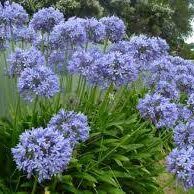Agapanthus Companion Plants: Perfect Pairings for Your Yard
Agapanthus Companion Plants: Perfect Pairings for Your Yard
Blog Article
Understanding the Art of Agapanthus Treatment: Vital Steps for Healthy Growth and Vibrant Blossoms
In the realm of cultivation, the cultivation of agapanthus stands as a fulfilling endeavor for those that look for to support these elegant flowering plants. With their striking blossoms and elegant vegetation, agapanthus has actually caught the focus of gardeners worldwide. Nonetheless, attaining optimum development and lively blooms calls for a nuanced approach that includes various important steps. From picking the right variety to mastering pruning methods, the journey towards cultivating thriving agapanthus plants is multifaceted and holds the key to opening the complete capacity of these botanical gems.
:strip_icc()/snow-storm-agapanthus-18f19b9a-3e7c6c88441b4127a9015f9a9fecec59.jpg)
Picking the Right Agapanthus Selection

When picking the ideal Agapanthus range for your garden, take into consideration elements such as environment viability, blossom shade, and growth routine. Additionally, take into consideration the climate in your region to make sure the Agapanthus range you select can grow in your particular conditions. Comprehending the growth behavior of various Agapanthus selections is critical for proper positioning within your yard.
Suitable Growing Conditions
Thinking about the optimal ecological demands is crucial for effective Agapanthus growing. Agapanthus plants are sensitive to cool temperatures and must be safeguarded from frost throughout wintertime months.
To ensure healthy growth and lively blooms, plant Agapanthus bulbs at a deepness of concerning 2-4 inches and room them 8-12 inches apart. Including natural issue, such as compost, to the dirt can enhance drainage and fertility, advertising robust root development. Mulching around the base of the plants assists retain wetness and subdues weed growth. Regular watering is vital, especially during the expanding period, to maintain the soil consistently wet but not waterlogged.
Watering and Feeding Tips
Preserving appropriate moisture degrees and supplying necessary nutrients are crucial elements in the treatment routine for Agapanthus plants. It is vital to strike a balance when it comes to sprinkling Agapanthus. If overwatered, these plants favor continually damp dirt however are vulnerable to root rot. During the expanding season, water deeply as soon as a why not look here week, making you could try here sure the soil is well-draining to avoid waterlogging. In hotter environments or during durations of drought, more frequent watering might be needed to maintain the dirt equally moist. Nonetheless, minimize watering in the winter season to prevent waterlogged problems.
Fertilizing Agapanthus is crucial for promoting healthy development and prolific blooms. Apply a well balanced plant food, such as a 10-10-10 formula, in the very early springtime as new growth arises. By following these watering and fertilizing ideas, you can guarantee your Agapanthus plants prosper and generate lively, resilient blooms.
Trimming Strategies for Agapanthus
Trimming Agapanthus plants at the appropriate times and with correct methods is essential for keeping their health and advertising ideal growth and flowering. The optimal time to prune Agapanthus is in late wintertime or early spring prior to new development emerges.
Deadheading spent blossoms can likewise redirect the plant's power into creating more blooms rather than setting seeds. If you want to collect seeds for proliferation, leave some blossoms to mature and completely dry on the plant.
Keep in mind to use clean, sharp devices to make exact cuts and minimize the threat of presenting diseases. Agapanthus. Routine pruning will aid keep your Agapanthus looking healthy and balanced and cool while making certain a plentiful display of lovely blossoms
Dealing With Typical Pests and Diseases
After guaranteeing proper pruning techniques for Agapanthus, it is important to resolve common pests and diseases that can impact the health and wellness and vigor of these plants. One usual parasite that impacts Agapanthus is the Agapanthus gall midget.
Furthermore, Agapanthus plants can suffer from root rot if they are grown in improperly draining dirt. By being alert and taking punctual action against illness and insects, you can aid your Agapanthus plants flourish and generate lively flowers. Agapanthus.

Verdict
Finally, mastering the art of agapanthus care involves selecting browse around this site the best selection, providing optimal planting problems, correct watering and feeding, ideal trimming strategies, and addressing typical bugs and diseases. By following these important actions, you can ensure healthy growth and dynamic blooms for your agapanthus plants. Bear in mind to frequently check and keep your plants to advertise their general well-being and durability.
To ensure healthy development and lively flowers, plant Agapanthus bulbs at a depth of concerning 2-4 inches and area them 8-12 inches apart. By adhering to these watering and feeding pointers, you can guarantee your Agapanthus plants thrive and create lively, lasting flowers.
One typical insect that impacts Agapanthus is the Agapanthus gall midget. In addition, Agapanthus plants can endure from origin rot if they are grown in badly draining pipes dirt. By complying with these crucial actions, you can ensure healthy growth and vivid flowers for your agapanthus plants.
Report this page